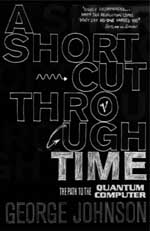'A shortcut through time'

A shortcut through time: the path to the quantum computer
By George Johnson
Most of us could not work without a computer, or have a good time without a CD player, and yet we know very little about the way computers work or the quantum mechanical principles behind lasers. These two subjects involve complex concepts and it is not easy to explain them in a brief book. Nevertheless, "A shortcut through time" manages to present a clear and enjoyable crash course on quantum computers, a science which lies at the intersection between quantum mechanics, computer science and mathematics.
Why does software always come without a guarantee? Why is the largest number that can be factorised by the fastest existing computer only 155 digits long? These are among the questions Johnson answers while explaining how quantum computation could break through the limitations of existing computers. He takes us through the development of quantum computers by sticking to the ideas and following the timeline of scientific development, all the while aiming for simplicity and emphasising that "a computer is just a box with a bunch of switches".
Taking quantum mechanics into account, a single particle can be in two places at the same time. This means that, whereas three ordinary switches can store any one of eight patterns, three quantum switches can hold all eight at once. This is the central difference between current computers and a quantum computer, and Johnson speculates about possible new mathematical puzzles that could arise from the applications of quantum computing.
After a brief introduction to quantum mechanics, Johnson talks about the difficulty of factorising numbers with many digits and compares the speed of classical and quantum computers. He describes the NP-complete problems (NP for nondeterministic polynomial time), which could only be solved if quantum computers could make random choices at every step of the computation. There is a section on cryptography, explaining how the security of current codes is based on the inability of current computers to factorise large numbers. And there are some possible applications of quantum computers, such as the generation of truly random numbers (which at the moment cannot be done by any computer) and high-speed quantum search. Finally, we can learn about the impediments that stand in the way of building a quantum computer and how these can be turned into new possibilities for computation.
The author presents himself as an outsider to the field alongside the reader, which makes the text more approachable but has the disadvantage that sometimes the discourse is a bit superficial. (There are no formulae.) But Johnson manages to transmit the excitement behind this young science, with its deep roots in the foundations of modern physics and position at the cutting edge of technology.
"A shortcut through time" will interest anyone with some curiosity for this new and potentially very important field. Johnson's chain of thought is straightforward, elegant and lucid. The use of plain language and the book's fewer than 200 fully illustrated pages (with no formulae) constitute a warm invitation that I recommend you do not turn down.
- Book details:
- A shortcut through time: the path to the quantum computer
- George Johnson
- paperback - 204 pages (2004)
- Vintage
- ISBN: 0099452170
Cristina Escoda is a second year Phd student at the University of Cambridge working on the phenomenology of String Theory and Supersymmetry. Cristina is an enthusiastic writer and very interested in science communication.
Anne_Carlill
I have just been introduced to NP problems in a course I'm studying. This review has helped to whet my appetite. I'd better have a go at understanding George Johnson's book.